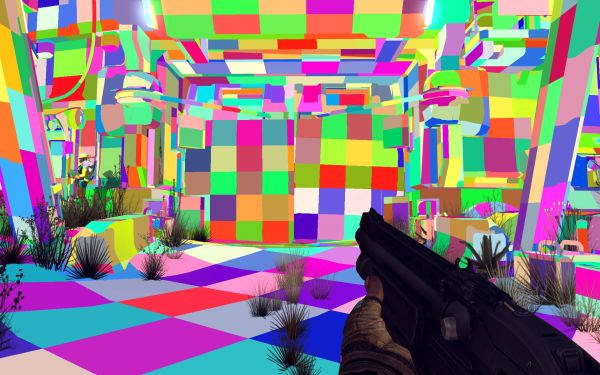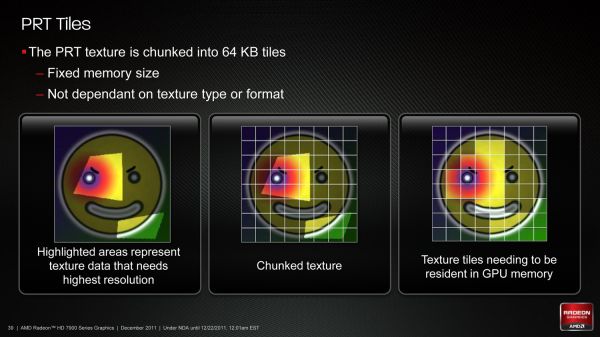AMD Radeon HD 7970 Review: 28nm And Graphics Core Next, Together As One
by Ryan Smith on December 22, 2011 12:00 AM EST- Posted in
- GPUs
- AMD
- Radeon
- ATI
- Radeon HD 7000
Partially Resident Textures: Not Your Father’s Megatexture
John Carmack’s id Software may not be the engine licensing powerhouse it was back in the Quake 3 days, but that hasn’t changed the revolutionary nature of his engine designs. The reason we bring this up is because there’s a great deal of GPU technology that can be directly mapped to concepts Carmack first implemented. For id Tech 4 Carmack implemented shadow volume technology, which was then first implemented in hardware by NVIDIA as their UltraShadow technology, and has since then been implemented in a number of GPUs. For id Tech 5 the trend has continued, now with AMD doing a hardware implementation of a Carmack inspired technology.
Among the features added to Graphics Core Next that were explicitly for gaming, the final feature was Partially Resident Textures, which many of you are probably more familiar with in concept as Carmack’s MegaTexture technology. The concept behind PRT/Megatexture is that rather than being treated as singular entities, due to their size textures should be broken down into smaller tiles, and then the tiles can be used as necessary. If a complete texture isn’t needed, then rather than loading the entire texture only the relevant tiles can be loaded while the irrelevant tiles can be skipped or loaded at a low quality. Ultimately this technology is designed to improve texture streaming by streaming tiles instead of whole textures, reducing the amount of unnecessary texture data that is streamed.
Currently MegaTexture does this entirely in software using existing OpenGL 3.2 APIs, but AMD believes that more next-generation game engines will use this type of texturing technology. Which makes it something worth targeting, as if they can implement it faster in hardware and get developers to use it, then it will improve game performance on their cards. Again this is similar to volume shadows, where hardware implementations sped up the process.
In order to implement this in hardware AMD has to handle two things: texture conversion, and cache management. With texture conversion, textures need to be read and broken up into tiles; AMD is going with a texture format agnostic method here that can simply chunk textures as they stand, keeping the resulting tiles in the same format. For AMD’s technology each tile will be 64KB, which for an uncompressed 32bit texture would be enough room for a 128 x 128 chunk.
The second aspect of PRT is managing the tiles. In essence PRT reduces local video memory to a very large cache, where tiles are mapped/pinned as necessary and then evicted as per the cache rules, and elsewhere the hardware handles page/tile translation should a tile not already be in the cache. Large tomes have been written on caching methods, and this aspect is of particular interest to AMD because what they learn about caching here they can apply to graphical workloads (i.e. professional) and not just gaming.
To that end AMD put together a technology demo for PRT based on Per-Face Texture Mapping (PTEX), a Disney-developed texture mapping technique that maps textures to polygons in a 1:1 ratio. Disney uses this technique for production rendering, as by constraining textures to a single polygon they don’t have to deal with any complexities that arise as a result of mapping a texture over multiple polygons. In the case of AMD’s demo it not only benefits for the reasons that Disney uses it, but also because when combined with tessellation it trivializes vector displacement, making art generation for tessellated games much easier to create. Finally, PRT fits into all of this by improving the efficiency of accessing and storing the Ptex texture chunks.
Wrapping things up, for the time being while Southern Islands will bring hardware support for PRT software support will remain limited. As D3D is not normally extensible it’s really only possible to easily access the feature from other APIs (e.g. OpenGL), which when it comes to games is going to greatly limit the adoption of the technology. AMD of course is working on the issue, but there are few ways around D3D’s tight restrictions on non-standard features.

















292 Comments
View All Comments
Scali - Saturday, December 24, 2011 - link
I have never heard Jen-Hsun call the mock-up a working board.They DID however have working boards on which they demonstrated the tech-demos.
Stop trying to make something out of nothing.
Scali - Saturday, December 24, 2011 - link
Actually, since Crysis 2 does not 'tessellate the crap' out of things (unless your definition of that is: "Doesn't run on underperforming tessellation hardware"), the 7970 is actually the fastest card in Crysis 2.Did you even bother to read some other reviews? Many of them tested Crysis 2, you know. Tomshardware for example.
If you try to make smart fanboy remarks, at least make sure they're smart first.
Scali - Saturday, December 24, 2011 - link
But I know... being a fanboy must be really hard these days..One moment you have to spread nonsense about how Crysis 2's tessellation is totally over-the-top...
The next moment, AMD comes out with a card that has enough of a boost in performance that it comes out on top in Crysis 2 again... So you have to get all up to date with the latest nonsense again.
Now you know what the AMD PR department feels like... they went from "Tessellation good" to "Tessellation bad" as well, and have to move back again now...
That is, they would, if they weren't all fired by the new management.
formulav8 - Tuesday, February 21, 2012 - link
Your worse than anything he said. Grow upCeriseCogburn - Sunday, March 11, 2012 - link
He's exactly correct. I quite understand for amd fanboys that's forbidden, one must tow the stupid crybaby line and never deviate to the truth.crazzyeddie - Sunday, December 25, 2011 - link
Page 4:" Traditionally the ROPs, L2 cache, and memory controllers have all been tightly integrated as ROP operations are extremely bandwidth intensive, making this a very design for AMD to use. "
Scali - Monday, December 26, 2011 - link
Ofcourse it isn't. More polygons is better. Pixar subdivides everything on screen to sub-pixel level.That's where games are headed as well, that's progress.
Only fanboys like you cry about it.... even after AMD starts winning the benchmarks (which would prove that Crysis is not doing THAT much tessellation, both nVidia and new AMD hardware can deal with it adequately).
Wierdo - Monday, January 2, 2012 - link
http://techreport.com/articles.x/21404"Crytek's decision to deploy gratuitous amounts of tessellation in places where it doesn't make sense is frustrating, because they're essentially wasting GPU power—and they're doing so in a high-profile game that we'd hoped would be a killer showcase for the benefits of DirectX 11
...
But the strange inefficiencies create problems. Why are largely flat surfaces, such as that Jersey barrier, subdivided into so many thousands of polygons, with no apparent visual benefit? Why does tessellated water roil constantly beneath the dry streets of the city, invisible to all?
...
One potential answer is developer laziness or lack of time
...
so they can understand why Crysis 2 may not be the most reliable indicator of comparative GPU performance"
I'll take the word of professional reviewers.
CeriseCogburn - Sunday, March 11, 2012 - link
Give them a month or two to adjust their amd epic fail whining blame shift.When it occurs to them that amd is actually delivering some dx11 performance for the 1st time, they'll shift to something else they whine about and blame on nvidia.
The big green MAN is always keeping them down.
Scali - Monday, December 26, 2011 - link
Wrong, they showed plenty of demos at the introduction. Else the introduction would just be Jen-Hsun holding up the mock card, and nothing else... which was clearly not the case.They demo'ed Endless City, among other things. Which could not have run on anything other than real Fermi chips.
And yea, I'm really going to go to SemiAccurate to get reliable information!